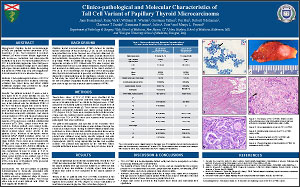Clinico-pathological and Molecular Characteristics of Tall Cell Variant of Papillary Thyroid Microcarcinoma
Jane Bernstein1, Renu Virk1, William H. Westra2, Giovanni Tallini3, Pei Hui1, Robert Udelsman1, Clarence T Sasaki1, Sanziana Roman1, Julie A Sosa1 and Manju L. Prasad1
Department of Pathology & Surgery, 1Yale School of Medicine, New Haven, CT, 2Johns Hopkins School of Medicine, Baltimore, MD, and 3Bologna University School of Medicine, Bologna, Italy
ABSTRACT
Background:
Papillary thyroid microcarcinomas (PTMC) are papillary thyroid carcinomas (PTC) measuring <1 cm. Their prognosis is excellent. However, a subset of them behave aggressively with recurrence, metastasis and cancer-specific mortality of up to 2%. The tall cell variant (TCV) of PTC is a particularly aggressive tumor that gener-ally presents in advanced stage and is associated with higher disease-related mortality. Recognizing this variant in PTMC may help select aggressive microcarcinomas for more intensive therapy.
Methods:
Clinico-pathological features of 23 TCV of PTMC in 21 patients were reviewed. DNA was extracted from tumor tissue and BRAF V600E mutational analysis was performed by single strand conformational polymorphism.
Results:
The patients included 17 women and 4 men aged 34 to 74 years (median 54 yrs). All patients underwent total thyroidectomy. Eleven of 21 thyroids (52%) contained multifocal PTMC but only in two patients was the additional PTMC of the TCV. The tumors ranged from 2 mm to 10 mm in size (median 7 mm). The majority of tumor cells were at least twice as tall as wide, had moderate to abundant eosinophilic cytoplasm, and classic nuclear features of PTC with frequent intranuclear inclusions. Four tumors showed lymphovascular invasion (17%) and seven exhibited extrathyroidal extension (pT3; 30%). Lymph nodes were dissected in fourteen patients, and showed metas-tases to level VI nodes (pN1a) in three (21%) and lateral cervical lymph nodes (pN1b) in two patients (14%). Nineteen of twenty-one tumors harbored BRAF V600E mutations (90%). Six of nineteen patients (31%) presented at advanced stage (III/IVA). These cases were compared with 23 age and size matched classic variants of PTMC which showed 26% (6/23) multifocality, no lymphovascular invasion or extrathyroidal extension, metastases to level VI nodes in 3 of 14 (pN1a, 21%) and metastasis to lateral cervical lymph nodes (pN1b) in one patient only (7.1%); and BRAF V600E mutation in 18/23 tumors (78%). Only three of 23 patients (13%) presented at an advanced stage (III/IVA).
Conclusions:
The tall cell variant of papillary microcarcinoma is frequently associated with multifocality, lymphovascular invasion, extra-thyroidal extension, advanced stage at presentation, and BRAF V600E mutation. Their recognition may help select patients with PTMC for more aggressive treatment.
©2012 Yale Department of Pathology. All rights reserved.
Any redistribution or reproduction of part or all of the contents in any form is prohibited. You may not, except with express written permission of the author or the Department of Pathology, distribute or commercially exploit the content, nor may you transmit it or store it in any other website or other form of electronic retrieval system, including use for educational purposes.
